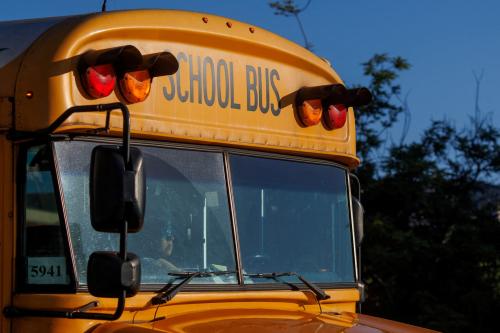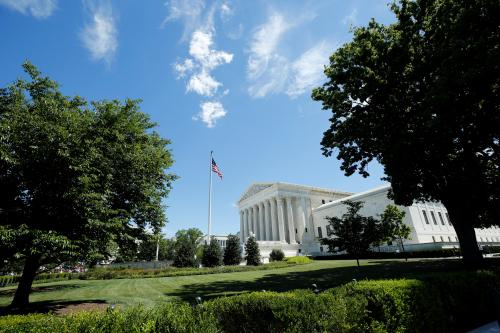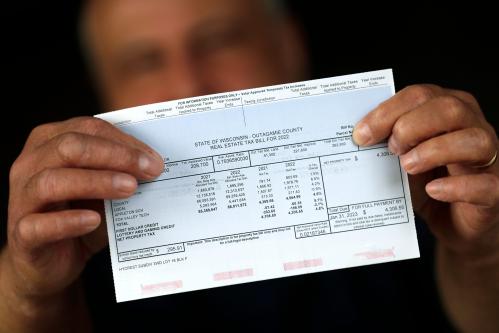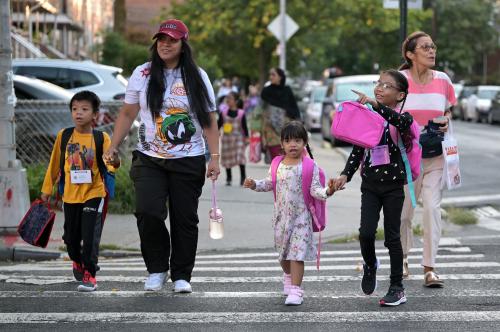Few things are more fundamental to a society than its traditions. They guide our actions through difficult and changing times. They keep us grounded and steady. They build on the wisdom of our forerunners. At least, that is the way conservatives, usually, look at the world.
But on one issue—school vouchers—some conservatives are playing the role of radicals. The general goal of vouchers is to allow families to use government funds to pay tuition at private schools, including religious schools. The idea has been around for more than a half-century but had gone almost nowhere in the U.S., until very recently. In just the past few years, it has gone from the political desert to a core issue that is sweeping across Republican-led states.
The general idea of vouchers is radical enough, but the particular form of these new programs is far more so. Fourteen states and counting have now passed legislation creating voucher (or education savings account) programs that share some key properties. They are universal (or nearly universal), meaning that all families are eligible. They involve no meaningful public accountability or way to judge their success. They allow private schools to charge tuition over and above the voucher amount. And, finally, they are flexible in that funds can be used even to cover homeschooling expenses and other educational goods and services, such as computers and tutoring.
These aren’t just any vouchers. They are “super-vouchers,” as I call them, that promise to produce the most radical change, of any kind, in U.S. education in at least 70 years. It represents not just a change in policy or strategy but a rejection of three foundational traditions: separation of church and state, anti-discrimination, and public accountability for educational processes and outcomes funded by taxes.
In this post, I describe the threat that today’s universal voucher programs present to these traditions, and I attend to some potential counterarguments from voucher supporters.
The separation of church and state tradition
America’s education traditions can be traced far back in our history. While the U.S. Constitution does not mention education, it was an issue actively discussed by the nation’s founders, and other elements of the Constitution have a heavy bearing on education. The First Amendment includes the Establishment Clause, which prevents Congress from either supporting or limiting the free exercise of religion. This language has long been understood to imply that governments should not fund religious organizations (including religious schools), especially in a way that preferences one religion over another.
As a result of education’s omission from the Constitution, primary responsibility for education was ultimately delegated to the states. Education is one of only a few topics covered in every state constitution—with all states guaranteeing universal access and most specifically mentioning public education. To many, this means that education should be not only funded by the government but accessible to all, subject to public oversight, and, yes, non-sectarian (non-religious).
It’s easy to see how vouchers, especially the new breed of them, violate these principles. Vouchers provide government funds to churches, despite the historical separation of church and state. Voucher advocates argue that today’s voucher systems are legal, and our current Supreme Court seems to agree, but that doesn’t change the fact vouchers will entangle the government and religion. With any voucher program, the government must decide which schools are eligible to receive funding. Will the public—in particular, citizens in red states where universal ESA programs are most popular—be just as willing to fund Islamic, Hindu, Jewish, and atheist schools as they are Christian schools? That’s not clear. Even if states treat all religions equally, some very public battles over religious schools will surely follow. Already, many voucher-supported religious schools have been the subject of front-page newspaper headlines regarding their most controversial teachings. We should expect this to continue.
Voucher proponents sometimes try to refute the idea that the separation of church and state for schooling even applies, pointing out that publicly funded schools taught religion in the early 1800s, with children reading from the Bible. However, a more complete telling of our history would note that the need for a separation between church and state became clearer as the country—and its students—grew more diverse. We shouldn’t use past wrongs to justify making the same mistakes today.
The anti-discrimination tradition
The U.S. Constitution, under the Fourteenth Amendment, establishes equal protection before the law. Ratified in the wake of the Civil War, this was meant to remediate the blatantly unequal treatment of Black people in every aspect of life, created by slavery. The Fourteenth Amendment can be viewed as reinforcing the accessible-to-all principle embodied in state constitutions.
This was not nearly enough, however, to provide meaningful access to Black Americans. Civil War Reconstruction efforts on education were modest and short lived. The Court’s 1896 Plessy v. Ferguson decision also established the principle of “separate but equal.” Even that low standard for access was not achieved, as few states provided more than a pittance in funding for Black schools. They were anything but equal for at least another half century. Then came the Court’s landmark 1954 Brown v. Board of Education decision, which reinterpreted the Fourteenth Amendment and rejected the separate-but-equal doctrine in schools. The decision began to slowly reorient public education towards an anti-discrimination tradition. Solidifying it was the Civil Rights Act of 1964, which banned discrimination on the basis of race, ethnicity, and national origin, and expanded the federal government’s authority to enforce anti-discrimination law in publicly funded programs (including public schools).
Most forms of vouchers undermine the anti-discrimination tradition. While private schools cannot legally discriminate based on race because of the Civil Rights Act, they can discriminate on most other dimensions, including religion, gender, gender identity, sexual orientation, class, income, and disability status. Moreover, the protections against racial discrimination are stronger in public schools, with additional avenues for recourse available to public school students through the U.S. Department of Education’s Office for Civil Rights.
Discrimination issues often arise in admissions, and private schools leaders believe strongly in their right to selective admissions requirements. Put another way, private school leaders feel they should be able to determine which students get in and which get turned away. While not all admission requirements are inherently problematic, private school admissions practices leave the door open for discrimination. And with potential discriminatory treatment hidden behind opaque admissions practices, it will be exceedingly difficult to identify discrimination where it occurs. When schools are allowed to discriminate on one set of factors, it is difficult to prove that a student is discriminated against based on other factors, such as race.
This is not just an abstract argument. The conflict between integration, discrimination, and vouchers was plain to see in the wake of Brown. Segregationists searched for ways to sidestep the Court’s decision. One main solution they stumbled upon: school vouchers. They understood well that vouchers would allow them to continue their discrimination.
Voucher advocates might resist my argument about the tradition of anti-discrimination, pointing to supposed examples of discrimination in public schools. For example, public schools “discriminate” against children who do not live within their geographic boundaries. It’s true that some families cannot afford to live in expensive neighborhoods with well-resourced schools. However, public school boundaries, for all their faults, are designed to ensure that all students have access to a public school—one of the core tenets of public education. When parents drive by a school, their children might ask, “Can I go to that school?” There’s a big difference between answering with, “No, dear, because we don’t live in this neighborhood” and “No, dear, because the school doesn’t want you.”
It’s worth noting, too, that voucher advocates need the universal accessibility of public schools for voucher programs to work. With voucher-supported schools allowed to discriminate in admissions, it’s the guaranteed availability of a neighborhood public school that ensures that no child will be denied access to any school at all.
The public accountability tradition
In the U.S., school districts operate under (typically elected) boards that provide public accountability—specifically, democratic accountability to the electorate. This approach has been the norm since the early 1900s. So, both in word and deed, public accountability has been a core principle for longer than anyone reading this can remember.
More recently, state and federal governments clawed back some of that power from local districts, especially through test-based accountability policies. One driving force behind the push for state and federal accountability was rising education spending from these levels of government. Taxpayers wanted to know what they were getting for their money, and test results were one way of measuring the return on their investments.
Even if one prefers a heavier dose of market accountability—giving families more choice—the government is still an important partner. If we want families to have more choices, then we should also want them to have more information, which the government is well positioned to provide.
Today’s voucher programs are unwinding our accountability traditions. They’re allowing families to use public funds to send their children to schools that do not operate under elected school boards. These schools are subject to little, if any, test-based accountability, and they need only meet the minimal bar of accreditation to participate. The recent crop of universal vouchers even fails in providing the information needed for market accountability. Yes, some students in some voucher states will be required to take some type of standardized test. However, it’s unclear whether and how these results will be reported, and even if they are widely available, parents will not be able to compare across disparate tests.
Voucher advocates sometimes point to programs like Social Security and the Earned Income Tax Credit (EITC) as programs that provide benefits to eligible recipients to make their own consumption decisions with few strings attached. But these programs give little reason to overthrow the public accountability tradition in education. This is basically saying, “yes, our voucher program ends the public accountability tradition in an area so important that the Founding Fathers and every state constitution includes it, but that’s okay…because we also give money to the elderly to make sure they can buy groceries.” If you find that logic confusing, I don’t blame you.
The Great Unwinding
It is no exaggeration to say that universal vouchers are unwinding two centuries of public education tradition, from the nation’s founding days to the present. We are not just talking about any traditions. These are traditions with roots in the First Amendment and our state constitutions, and ones that have shaped the foundational contours of K-12 education in this country.
Voucher advocates might point out that the Supreme Court has reversed itself on vouchers in recent years, giving reason to believe that today’s programs are legally permissible. But U.S. and state constitutions aren’t just legal documents to be interpreted by lawyers and judges. They convey larger, foundational principles and traditions at play that have guided American life, including education, for centuries. The public broadly supports these traditions, regardless of what the courts say.
We do need to upend traditions from time to time. Brown v. Board upended the disgraceful mistreatment of and discrimination against Black Americans. That was a widely accepted step forward. Is it time to end church-state separation, public accountability, and anti-discrimination? You be the judge.







Commentary
The new and radical school voucher push is quietly unwinding two centuries of U.S. education tradition
August 13, 2024